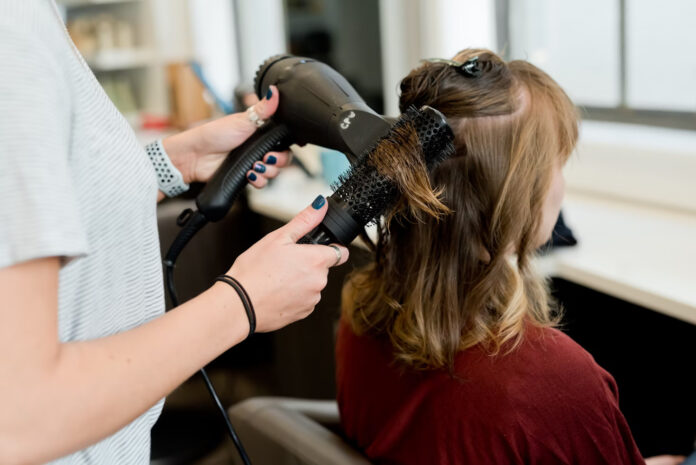Sleek, straight hair flaunted by models and celebrities fuels a multi-billion-dollar industry built around chasing the dream of smooth, frizz-free locks. Women today know the power of a good hair day, and many rely on chemical straighteners to tame their curls or coils.
Who doesn’t enjoy that salon-fresh feeling after a long appointment armed with flat irons and formaldehyde-releasing treatments?
Yet underneath the superficial sheen, repeated exposure to powerful chemicals and heat takes a toll.
Through this blog, we aim to empower women and help them strike a delicate balance. Read on to explore tips on selecting safer straightening products, techniques that reduce damage, and perspectives on embracing the gorgeous hair you were born with.
Knowing the Hidden Threats
In a recent, large-scale study of the hair care routines of over 33,000 women, a link was observed between the routine use of chemical hair products and the onset of uterine cancer.
Women who used these products at least four times a year were shown to have more than twice the risk compared to those who didn’t. This finding warrants further investigation and raises crucial questions about the potential health consequences of certain hair care practices.
Shouldn’t there be a balance between chasing what society deems picture-perfect straight hair while preserving health and self-acceptance?
The goal is informed choice, not perfection. With some care, you can enjoy the versatility of straighter styles without sacrificing what makes you unique—your health and your texture.
The Promises and Pitfalls of Straight Hair
Around the turn of the 20th century, entrepreneur Annie Turnbo Malone developed a chemical straightener made from eggs, soap flakes, and vegetables. Her Wonderful Hair Grower was a hit, promising to soften coarse hair in a matter of a few latherings.
Over the next few decades, straight hair became cemented in mainstream culture as the ideal, professional style for women of all backgrounds.
Shiny, pin-straight hair graced the covers of magazines and albums, immortalizing icons like Farrah Fawcett and Cher. Not surprisingly, chemical straighteners soared in society, and so did hair damage.
Formaldehyde, a known carcinogen, was a chief component in hair straighteners for many years, before 2023. But this loyalty to the chemical has come at a cost.
According to TorHoerman Law, prolonged exposure to formaldehyde is linked to increased cancer risk. Beyond the carcinogenic concerns, parabens and phthalates present in hair care products can cause hormonal disruption. These chemicals mimic natural hormones and, thus, can interfere with the body’s delicate endocrine system.
This disruption is linked to an increased risk of uterine cancer, the most common form of cancer among women.
This information isn’t meant to instill fear in you, but rather to empower informed choices. As someone who buys cosmetics and related products, it’s important for you to know exactly what is being sold to you and to understand any possible dangers they might pose.
Several affected people are accusing big enterprises, ie, L’Oreal and Revlon, of misleading their customers by hiding the risks associated with formaldehyde-based products.
If you have suffered severe health issues, mentioned above, after the prolonged use of hair straightener products, or, you know someone else who has, you can file a hair straightener lawsuit with the help of an attorney.
By being aware of the concerns surrounding common hair care chemicals, you can make conscious decisions that enhance not only your style but also your well-being.
Choosing Products Carefully
If you wish to straighten your hair every once in a while, start by selecting quality salon-grade products. You might want to use drugstore kits that seem affordable, but they often contain harsh chemicals that can damage hair over time.
When choosing products, read the ingredients list to avoid certain chemicals. Stay away from lye relaxers that use sodium hydroxide or guanidine hydroxide – these break hair bonds quite aggressively. Better options are “no-lye” relaxers with ammonium thioglycolate.
Also look for natural oils like avocado, coconut, or argan which nourish hair during the straightening process.
Embracing Your Roots
For many years, young Black women have felt the pressure to straighten their naturally curly hair to conform to mainstream beauty standards. And, if you can believe it, some receive their first chemical straightening at age five!
However, recent studies have linked the long-term use of these hair products to health issues like uterine cancer. In 2023, the FDA banned formaldehyde in hair treatments due to safety concerns.
In light of these risks, and in an attempt to redefine beauty standards, a growing “natural hair” movement is taking shape. It celebrates the beauty of Black hair in its natural state. More celebrities and influencers are now wearing their hair in braids, afros, twists, and other styles that embrace texture instead of fighting it.
The choice to periodically straighten hair for special occasions is a personal one. But prioritizing self-acceptance and hair health means moving away from the idea that natural hair is inherently “unprofessional” or needs to be permanently changed with harsh chemicals.
By starting the conversation, you can redefine beauty norms while supporting the health and confidence of your peers.









